The latest Canadian census shows the North Okanagan’s population has grown by 8.6 per cent since 2016, to a total of 91,610 people.
That makes the North Okanagan the seventh fastest growing regional district in B.C., tied with Okanagan-Similkameen.
Further breaking down the 2021 population census, here are the population changes for North Okanagan municipalities, ranked by growth rate.
Lumby
2016 population: 1,833
2021 population: 2,063
Percentage change: 12.5
Density per square km: 347.7
Vernon
2016 population:40,116
2021 population: 44,519
Percentage change: 11
Density per square km: 461.7
Coldstream
2016 population: 10,648
2021 population: 11,171
Percentage change: 4.9
Density per square km: 167.8
Armstrong
2016 population: 5,114
2021 population: 5,323
Percentage change: 4.1
Density per square km: 1,020
Spallumcheen
2016 population: 5,106
2021 population: 5,307
Percentage change: 3.9
Density per square km: 20.8
Enderby
2016 population: 2,964
2021 population: 3,028
Percentage change: 2.2
Density per square km: 710.4
Lumby topped the list with a 12.5 per cent population increase — a benefit to the small village, according to Mayor Kevin Acton.
“Moderate growth is always good for a village of our size as the cost versus infrastructure and services are challenging,” said Acton. “The growth helps offset potential tax increases.”
Acton said he thinks there are several factors driving the village’s growth. One is that Lumby is a beautiful area with no major highway running through it. Also, the community is safe and family-oriented, with lots of park space and outdoor access and a close proximity to major cities and the Kelowna International Airport.
“Challenges to growth remains the same: lack of housing of all sectors,” Acton said.
Overall, the province of B.C. reached the five million mark thanks to a 7.6 per cent population increase since the last census.
The federal government is doling out the findings of the 2021 census throughout 2022. Population data was released Wednesday, Feb. 9. On April 27, demographic data will be released. On July 13, information on family households, military experience and Canadians’ income will be shared.
Language statistics will be shared Aug. 17; First Nations, Métis and Inuit statistics will be shared Sept. 21; immigration, religion and migration data will be released Oct. 26; and education and labour data will be released Nov. 30.
READ MORE: B.C. population tops 5M in 2021, province grows by 7.6% since 2016
READ MORE: More people moved to B.C. than elsewhere in Canada in the last year: StatCan
